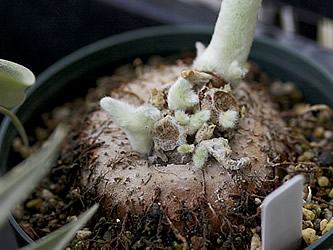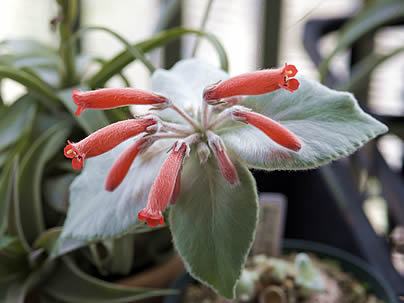The Brazilian Edelweiss (Sinningia leucotricha) is a herbaceous, tuberous plant with ornamental foliage and flowering, native to Paraná in southern Brazil. It features a main tuberous root with the upper part exposed above the ground, having a brownish and rough cortex, and a rounded shape that slowly grows year after year without dividing, reaching an incredible 30 cm (approximately 12 inches) in diameter in older plants. The thinner secondary roots play a crucial role in anchoring the plant and absorbing water and nutrients from the soil.
These roots are essential as this species originates from steep slopes with few resources and is often subjected to weathering. Usually, only one erect branch emerges from the top of the main root, with few branches and two pairs of developed and opposite leaves, along with smaller ones. Specimens with a larger diameter often produce multiple branches, forming a beautiful ensemble reminiscent of the caudex of some succulents. Both the branches and leaves are covered with a dense, long, and soft hairiness, giving the plant a woolly, silvery, and unique appearance. Soon after the development of branches and leaves, tubular flowers in shades ranging from salmon to reddish emerge, attracting hummingbirds.

Depending on the climate in which it is cultivated, the Brazilian Edelweiss may be deciduous or evergreen. Generally, in temperate to subtropical climates, it sheds its branches and leaves in winter and regrows in spring, blooming shortly afterward. In warmer climates, it tends to retain its leaves for up to two years before regrowing, not entering dormancy. Some gardeners achieve two consecutive flowerings by cutting the stems as soon as the flowering ends to stimulate the growth of new branches and subsequent flowering.
It should be cultivated in full sun or partial shade, in fertile, well-draining soil, and irrigated at sparse intervals. The Brazilian Edelweiss does not tolerate waterlogging, quickly succumbing to fungal and bacterial diseases under such conditions. It is interesting to cultivate it in substrates suitable for succulents due to the species’ peculiarities.
Although it can be planted directly in the garden, it is more common to plant the Brazilian Edelweiss in pots to observe closely all its curious characteristics. It easily multiplies by seeds, which are tiny and should be sown as soon as they are collected in sandy substrate, kept moist. Vegetative propagation of this species is still challenging, as it does not produce new shoots from the roots, and cuttings are often difficult to root.


